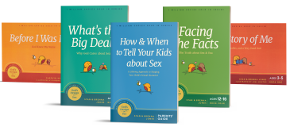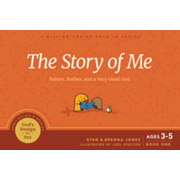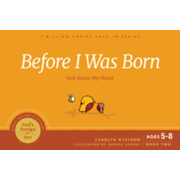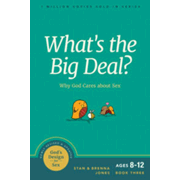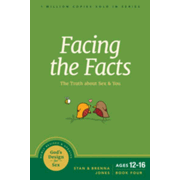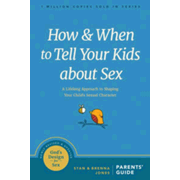The third editions of the books in the God’s Design for Sex Series were published in 2019. The series consists of four books for children and one for adults. All of these books are written from a biblical Christian perspective. The series promotes premarital sexual abstinence for teenagers and young adults, and it presents monogamous male-female marriage as God’s intended context for sexual intimacy and for having children. They occasionally make reference to various types of family situations such as adoption and single parenting, but they do not include families led by homosexual couples.
The books discuss sexual matters tastefully but frankly, so it is vital that parents pre-read to make sure they are suitable for their children. The authors comment in “An Important Word to Parents” (a forward in each book) that:
[W]e are guaranteed to say something to lead almost any Christian parent to declare us too conservative or too liberal on some topic or to disagree with us somewhere. We do not presume our answers are completely right. At the very least, we hope our thoughts empower you, the parent, to think the matter through and present a better answer to your child as the Lord guides your thinking.
Family values differ, and individual children start to exhibit curiosity on their own timetables. So parents need to make their own decisions about when to discuss sexual issues. With that in mind, the God’s Design for Sex series gives parents tools to use for those discussions.
The Story of Me: Babies, Bodies, and a Very Good God
The Story of Me: Babies, Bodies, and a Very Good God is suitable as a read-aloud book for ages three to five. In this book, a young child asks questions of his parents, and they tell about how babies are made without discussing intercourse directly. It discusses pregnancy and childbirth, including mention of both vaginal and C-section deliveries. While language is used very carefully, specific terms for genital organs are used. One page addresses inappropriate touching of private parts. Joel Spector’s lovely, soft-edged, full-color illustrations fill every other page of the story in this 45-page book.
Before I Was Born God Knew My Name
Before I Was Born God Knew My Name is to be used as a read-aloud book for ages five to eight. This is the only book in the series that was written by Carolyn Nystrom, and it features full-color illustrations by Sandra Speidel on most of its 45 pages.
The writing style begins like a storybook: “Long ago, before there was moon or sun or stars or anything else, there was God. God knew you. And he loved you—even then” (p. 12). The first few pages continue to tell about God’s creation then narrow the focus to the creation of a man and a woman.
There’s a little disconnect as the style of the writing switches from storytelling to a more informational style. Also, the book sort of abruptly shifts to talk about the birth of babies and the differences between boys and girls. At that point, it goes on to explain the changes that occur during maturation.
A discussion about marriage leads into a description of intercourse that is fairly explicit. The book continues with information about conception and growth within the womb up through childbirth. There are illustrations of a child being born and of the baby nursing. All of this is presented as part of God’s plan in a positive and loving manner.
What’s the Big Deal?: Why God Cares about Sex
What’s the Big Deal?: Why God Cares about Sex is for ages eight to twelve. This 87-page book has far more information than the first two books. There are just a few illustrations and no color, and the intent is for parents to read it aloud with children. It is set up as conversations between a mom and dad and their son and daughter, Sam and Amy. The authors suggest having your own children read the Sam and Amy parts while you and your spouse read the mom and dad sections. Even though some sections are conversations between only Amy and mom or only Sam and dad, the authors say that all of the material is intended for both boys and girls.
This book gets into heavy topics. It uses the children’s questions to launch the discussions, beginning with Sam asking, “Dad, what’s the big deal about sex? Why do people talk and joke so much about sex, like on TV and stuff?” Dad responds with a somewhat broad explanation that “sex is a wonderful and beautiful gift from God.” The conversation moves into more detail pretty quickly as it shifts into a discussion about inappropriate sexual relationships, identifying them as a misuse of God’s gift. The second conversation gets into the biological specifics of intercourse. This is followed by a discussion about sex outside of marriage and then an entire chapter concerning what the Bible has to say about it.
The next few chapters are about puberty and maturation changes. Then two chapters center around sexually-oriented movies and entertainment as well as pornography. Next is a chapter on homosexuality and gay marriage. A discussion about sexual abuse is included to alert children to situations that they might encounter and how they might protect themselves.
The next to last chapter, “God’s Response to Wrong,” lets children know that God still loves those who commit sexual sins, even though they need to repent. It goes on to discuss consequences such as out-of-wedlock pregnancies, the need for condoms, and the idea of safe sex. The book concludes on a positive note as it discusses faith, courage, and trust in God.
Each chapter has a few discussion questions that you might use if they seem helpful.
Facing the Facts: The Truth About Sex and You
Facing the Facts: The Truth About Sex and You, which is recommended for ages 12 to 16, has been significantly expanded from the previous edition to address current issues. The book is presented in three parts: Getting the Big Picture, Understanding the Facts, and Putting It into Practice.
The first part begins by tying sexual decision-making to worldview beliefs, urging students toward a Christian worldview so that they will understand both the concept of sex being a gift from God and God’s views about sex.
The second part discusses sexual differences, puberty and maturation, intercourse (explicitly), conception, pregnancy, and birth.
The third part gets into issues where a biblical viewpoint conflicts with that of popular culture. It discusses the sexual revolution in a negative way. It spends two chapters on “Saving Sex for Marriage,” dealing with it first from a practical perspective, then from a biblical. Next, the book deals with dating and romance before marriage, including the question, “How far should I go?”
The next four chapters address masturbation, pornography, homosexuality, and gender identity. These chapters are followed by a catch-all chapter that touches on issues such as the bad example of parents, public school sex education that rejects Christian values, broken families, and sexual abuse within families. While one could wish that teenagers would not need to know so much—and maybe your teen doesn’t need to know all of it yet—the authors don’t just expose them to dismal information and leave it there. Instead, they try to steer teens toward positive, God-honoring choices.
The book concludes with a chapter that urges teens to make positive decisions, accept personal responsibility, and grow in faith and obedience to God.
How & When to Tell Your Kids about Sex: A Lifelong Approach to Shaping Your Child’s Sexual Character
How & When to Tell Your Kids about Sex: A Lifelong Approach to Shaping Your Child’s Sexual Character is a book for parents that is presented in five parts: Foundations, The Cornerstone Years, The Preparatory Years, The Transitional Years, and The Pivotal Years. In addition to covering basic information, the authors take on topics that are controversial even among Christians, such as courtship versus dating and the use of contraception. They present a range of views for parents to consider along with their own personal views.
The first part covers general topics such as the principles of Christian sex education, biblical foundations for understanding sexuality, challenges that parents face, character formation, and recommended resources.
In the second part, the Cornerstone Years, the authors discuss topics pertinent to the years from birth through kindergarten. While this section talks about building foundations of strong family life, love, trust, and positive attitudes toward sex in its proper place, it also discusses issues such as gender identity, sexual curiosity, sexual orientation, and sexual molestation.
The Preparatory Years section deals with the prepuberty stage. It discusses preparing children for sexual changes and challenges. It includes the dangers that technology might pose in exposing children to pornography, predators, and other sexual exploitation.
The fourth part, Transitional Years, refers to the transition through puberty. This section covers sexual attraction, dating, courtship, chastity, sexual activity when dating, and masturbation.
The fifth part, the Pivotal Years, discusses ways to support adolescents through this difficult period. It also has an entire chapter on contraception. While it presents information about various forms of contraception, their practical medical aspects, and their effectiveness, it also addresses challenging questions such as whether or not parents should allow their daughters to use contraceptives, the moral aspects of different types of contraception, and conflicting views of some branches of Christianity regarding contraception. The concluding chapter of the book discusses the nature of true purity.




